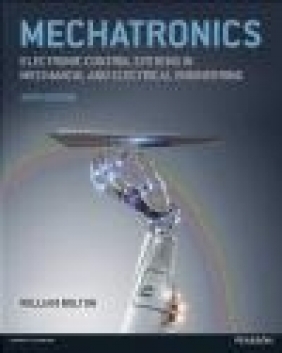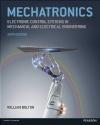Mechatronics
W. Bolton
Mechatronics
W. Bolton
- Producent: Pearson
- Rok produkcji: 2015
- ISBN: 9781292076683
- Ilość stron: 664
- Oprawa: Miękka
Niedostępna
Opis: Mechatronics - W. Bolton
The integration of electronic engineering, mechanical engineering, control and computer engineering - Mechatronics - lies at the heart of the innumerable gadgets, processes and technology without which modern life would seem impossible. From auto-focus cameras to car engine management systems, and from state-of-the-art robots to the humble washing machine, Mechatronics has a hand in them all.Preface Introduction 1 Introducing mechatronics Chapter objectives 1.1 What is mechatronics? 1.2 The design process 1.3 Systems 1.4 Measurement systems 1.5 Control systems 1.6 Programmable logic controller 1.7 Examples of mechatronic systems Summary Problems Sensors and signal conditioning 2 Sensors and transducers Chapter objectives 2.1 Sensors and transducers 2.2 Performance terminology 2.3 Displacement, position and proximity 2.4 Velocity and motion 2.5 Force 2.6 Fluid pressure 2.7 Liquid flow 2.8 Liquid level 2.9 Temperature 2.10 Light sensors 2.11 Selection of sensors 2.12 Inputting data by switches Summary Problems 3 Signal conditioning Chapter objectives 3.1 Signal conditioning 3.2 The operational amplifier 3.3 Protection 3.4 Filtering 3.5 Wheatstone bridge 3.6 Pulse modulation 3.7 Problems with signals 3.8 Power transfer Summary Problems 4 Digital signals Chapter objectives 4.1 Digital signals 4.2 Analogue and digital signals 4.3 Digital-to-analogue and analogue-to-digital converters 4.4 Multiplexers 4.5 Data acquisition 4.6 Digital signal processing Summary Problems 5 Digital logic Chapter objectives 5.1 Digital logic 5.2 Logic gates 5.3 Applications of logic gates 5.4 Sequential logic Summary Problems 6 Data presentation systems Chapter objectives 6.1 Displays 6.2 Data presentation elements 6.3 Magnetic recording 6.4 Optical recording 6.5 Displays 6.6 Data acquisition systems 6.7 Measurement systems 6.8 Testing and calibration Summary Problems Actuation 7 Pneumatic and hydraulic actuation systems Chapter objectives 7.1 Actuation systems 7.2 Pneumatic and hydraulic systems 7.3 Directional control valves 7.4 Pressure control valves 7.5 Cylinders 7.6 Servo and proportional control valves 7.7 Process control valves 7.8 Rotary actuators Summary Problems 8 Mechanical actuation systems Chapter objectives 8.1 Mechanical systems 8.2 Types of motion 8.3 Kinematic chains 8.4 Cams 8.5 Gear trains 8.6 Ratchet and pawl 8.7 Belt and chain drives 8.8 Bearings 8.9 Mechanical aspects of motor selection Summary Problems 9 Electrical actuation systems Chapter objectives 9.1 Electrical systems 9.2 Mechanical switches 9.3 Solid-state switches 9.4 Solenoids 9.5 D.C. motors 9.6 A.C. motors 9.7 Stepper motors Summary Problems Microprocessor systems 10 Microprocessors and microcontrollers Chapter objectives 10.1 Control 10.2 Microprocessor systems 10.3 Microcontrollers 10.4 Applications 10.5 Programming Summary Problems 11 Assembly language Chapter objectives 11.1 Languages 11.2 Instruction sets 11.3 Assembly language programs 11.4 Subroutines 11.5 Look-up tables 11.6 Embedded systems Summary Problems 12 C language 12.1 Why C? 12.2 Program structure 12.3 Branches and loops 12.4 Arrays 12.5 Pointers 12.6 Program development 12.7 Examples of programs 12.8 Arduino programs Summary Problems 13 Input/output systems Chapter Objectives 13.1 Interfacing 13.2 Input/output addressing 13.3 Interface requirements 13.4 Peripheral interface adapters 13.5 Serial communications interface 13.6 Examples of interfacing Summary Problems 14 Programmable logic controllers Chapter objectives 14.1 Programmable logic controllers 14.2 Basic PLC structure 14.3 Input/output processing 14.4 Ladder programming 14.5 Instruction lists 14.6 Latching and internal relays 14.7 Sequencing 14.8 Timers and counters 14.9 Shift registers 14.10 Master and jump controls 14.11 Data handling 14.12 Analogue input/output Summary Problems 15 Communication systems Chapter objectives 15.1 Digital communications 15.2 Centralised, hierarchical and distributed control 15.3 Networks 15.4 Protocols 15.5 Open Systems Interconnection communication model 15.6 Serial communication interfaces 15.7 Parallel communication interfaces 15.8 Wireless protocols Summary Problems 16 Fault finding Chapter objectives 16.1 Fault-detection techniques 16.2 Watchdog timer 16.3 Parity and error coding checks 16.4 Common hardware faults 16.5 Microprocessor systems 16.6 Emulation and simulation 16.7 PLC systems Summary Problems System models 17 Basic system models Chapter objectives 17.1 Mathematical models 17.2 Mechanical system building blocks 17.3 Electrical system building blocks 17.4 Fluid system building blocks 17.5 Thermal system building blocks Summary Problems 18 System models Chapter objectives 18.1 Engineering systems 18.2 Rotational-translational systems 18.3 Electromechanical systems 18.4 Linearity 18.5 Hydraulic-mechanical systems Summary Problems 19 Dynamic responses of systems Chapter objectives 19.1 Modelling dynamic systems 19.2 Terminology 19.3 First-order systems 19.4 Second-order systems 19.5 Performance measures for second-order systems 19.6 System identification Summary Problems 20 System transfer functions Chapter objectives 20.1 The transfer function 20.2 First-order systems 20.3 Second-order systems 20.4 Systems in series 20.5 Systems with feedback loops 20.6 Effect of pole location on transient response Summary Problems 21 Frequency response Chapter objectives 21.1 Sinusoidal input 21.2 Phasors 21.3 Frequency response 21.4 Bode plots 21.5 Performance specifications 21.6 Stability Summary Problems 22 Closed-loop controllers Chapter objectives 22.1 Continuous and discrete control processes 22.2 Terminology 22.3 Two-step mode 22.4 Proportional mode 22.5 Derivative control 22.6 Integral control 22.7 PID controller 22.8 Digital controllers 22.9 Control system performance 22.10 Controller tuning 22.11 Velocity control 22.12 Adaptive control Summary Problems 23 Artificial intelligence Chapter objectives 23.1 What is meant by artificial intelligence? 23.2 Perception and cognition 23.3 Reasoning 23.4 Learning Summary Problems Conclusion 24 Mechatronics systems Chapter objectives 24.1 Mechatronic designs 24.2 Case studies 24.3 Robotics Summary Problems and assignments Appendices A The Laplace transform A.1 The Laplace transform A.2 Unit steps and impulses A.3 Standard Laplace transforms A.4 The inverse transform Problems B Number systems B.1 Number systems B.2 Binary mathematics B.3 Floating numbers B.4 Gray code Problems C Boolean algebra C.1 Laws of Boolean algebra C.2 De Morgan laws C.3 Boolean function generation from truth tables C.4 Karnaugh maps Problems D Instruction sets E C library functions F MATLAB and SIMULINK F.1 MATLAB F.2 SIMULINK G Electrical circuit analysis G.1 D.C. circuits G.2 A.C. circuits Further information Answers Index
Producent:
GPSR Pearson Central Europe Sp. z o.o.
ul. Szamocka 8
01-748 Warszawa (PL)
tel: 459 596 060
email: [email protected]
Szczegóły: Mechatronics - W. Bolton
Tytuł: Mechatronics
Autor: W. Bolton
Producent: Pearson
ISBN: 9781292076683
Rok produkcji: 2015
Ilość stron: 664
Oprawa: Miękka
Waga: 1.26 kg
Recenzje: Mechatronics - W. Bolton
Informacje:
Inne pozycje tego autora: W. Bolton (18)
- Wymyśliłam Cię (Marginesy) - miękka
- Wounded. Ostatnie słowa. Tom 2 (Egmont) - twarda
- Trump w Białym Domu (Bellona) - twarda
- Jaskółka i koliber (Świat Książki) - okładka miękka
- Ulubione rzeczy (Amber) - Miękka
- Skąd ja panią znam (Prószyński i S-ka) - Miękka
- Szklany pokój. Seria Vera. Tom 5 (Amber) - Miękka
- Nieznajoma żona (Amber) - Miękka
- Jack Reacher: 61 godzin (Albatros) - Miękka
- Żółtodziób (LTW) - okładka miękka
- Minecraft. Nauki przyrodnicze. Megazadania. 7-11 lat (HarperKids) - Miękka
- Minecraft. Inżynieria i mechanika. Megazadania. 7-11 lat (HarperKids) - Miękka
- Nad jeziorem (Amber) - Miękka
- Sezonowa dziewczyna (Albatros) - Miękka
- Minecraft. Projektowanie i technologia. Megazadania. 7-11 lat (HarperKids) - Miękka
- Minecraft. Informatyka i programowanie. Megazadania. 7-11 lat (HarperKids) - Twarda
- Sandman. Teatr tajemnic. Księga druga (Egmont) - Twarda
- Nieznajoma żona (Amber) - Miękka


















